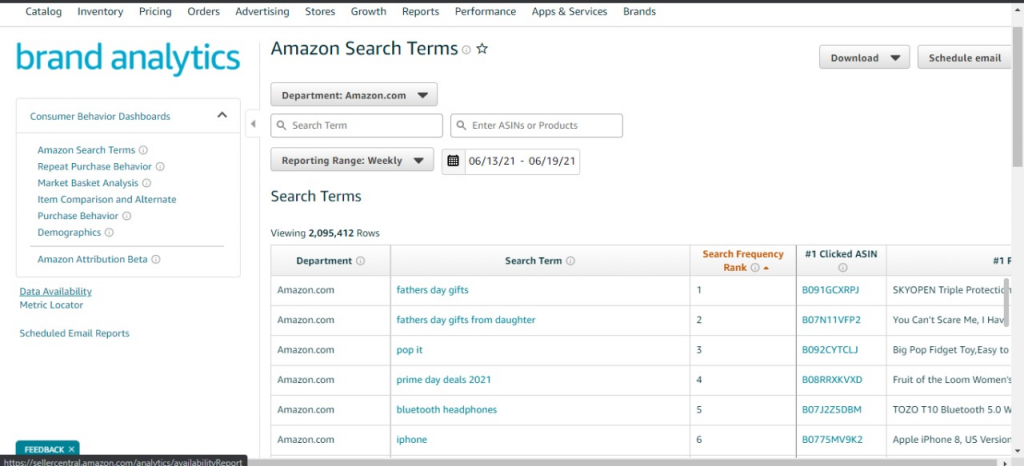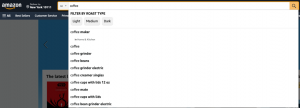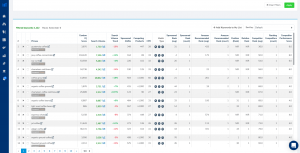Amazon’s new Brand Analytics has been the talk of not only Amazon dealers but also competitors. The data released by this tool is a treasure trove for anyone curious about what consumers’ search and purchase history on Amazon. It provides invaluable insight into how people shop online and valuable information to other e-commerce businesses trying to get an edge in their respective markets. It promises unprecedented insights from consumer trends across all categories. You can now track your products’ performance against others with similar attributes so every company out there can better understand customer habits.
Read More:- 5 Things You Need to Know to Master Amazon Keywords
[toc]
Search Terms Report

The Brand Analytics Search Terms report is essential for any brand owner who wants to know how customers find their products on Amazon. The most popular search terms at that instant will be displayed, and each term’s popularity rank can tell you which keywords are driving traffic your way.
The new Brand Analytics Report lists all the top-searched words that lead people to purchase various brands’ products in one handy tool, ranking them by frequency from 1st place down through 10th place. This information lets marketers make smarter decisions about how they advertise or market themselves online. They’re not wasting money promoting lower-ranked words when it turns out those aren’t as effective – even though more people might have typed those phrases into Google.
It Requires Proper Keyword Research

In order to have a successful Amazon campaign, you need more than just an impressive Search Frequency Rank tool. You also have to look through the data and remove any guesswork from keyword research by analyzing what keywords are most popular among customers on Amazon. This is because these search terms will be searched for again in future sessions as they rank higher due to their popularity within the retailer’s ecosystem.
Here are a few things you need to understand about the search frequency tool:
- The ASINs are ranked by click share, but this doesn’t necessarily mean the conversion rate is the highest. In some cases, the third-ranked ASIN has higher rates than those in first or second place because it may be a more specific product with fewer clicks and conversions to dilute its data set.
- The search term function does not treat close variants and misspellings the same way as a normal keyword, so experiment with every possibility when determining your best keywords. Test synonyms to find the highest searched terms that will provide you more accurate results than typing in words manually while also allowing you to filter out any irrelevant or unproductive phrases from appearing on your list of potential options.
The number of searches is not cumulative. There could be a handful, or there could be billions of searches between each search frequency rank, and you won’t be able to tell how many there are because the numbers vary between ranks.
Read More:- Easy Way to Track Amazon Keywords Ranking Using AMZ WordSpy
Effective in Single Keyword Campaigns

The Search Terms report of Brand Analytics offers recommendations for single keyword campaigns by highlighting the most favored attribute of your product and scraping out the most accurate, most popular search terms for your product. Utilize this resource to ensure that you’re getting as many clicks on a high-performing campaign name as possible. The frequency rank tool within Brand Analytics will inform you which words are searched more frequently than others so that you can decide which term is worth going with when naming or publicizing one of our marketing endeavors.
Single keyword campaigns are created because they have a high volume of traffic and can be controlled to maximize benefits. Knowing your highest search term by the frequency rank, you will know where to place your single-keyword campaign for maximum results.
Single keyword campaigns are a great way to get high traffic and maximize your profits. If you know the hottest keywords, then it’s easy to place ads in positions that will earn you more money for each click-through. All placement settings should be optimized accordingly because no two keywords perform exactly alike across different ad placements. This is difficult with less specific campaign types such as sponsored product campaigns—those have wildly varying performance depending on where they’re placed in search results pages.
Read More:- WordSpy | Right Amazon Keywords Research Tool For Product Listings Optimization
Track Important Metrics
Sales Diagnosis:
If you’re a savvy merchant, then your product is up for sale in many different online stores. However, if one of them has outpriced the others and won deals by doing so-called “loss-leading” – that’s where they price low to win market share but make it back on volume later – this could spell trouble. Luckily, there are tools like Sales Diagnostic, which lets brands review performance at any level relative to specific timeframes and essential metrics such as Lost Buy Box Due To Price when considering third-party sellers of their products.
Traffic Diagnosis:
The Fast Track Glance View Rate shows the percentage of your inventory available for Prime shipping when a glance view occurs. We recommend brands stay above 85% to ensure that they are meeting Amazon’s ordering parameters, and this metric will be difficult to exceed if you’re growing as most customers end up browsing detail pages. Additionally, the Change in Unique Visitors option can help track new customer views on listings – an important way to grow revenue!
Customer Behavior:
Customer Behavior – There are several Customer Behavior reports which allow you to analyze ASINs as well as competitor websites so they know exactly where people go once their initial search has been completed. The report shows everything from Product Listing Ads (PLA) impressions created by Amazon and clicks generated on those ads.








